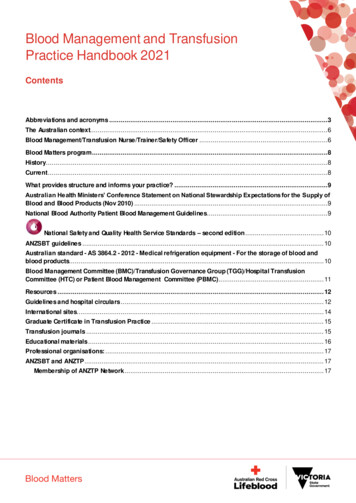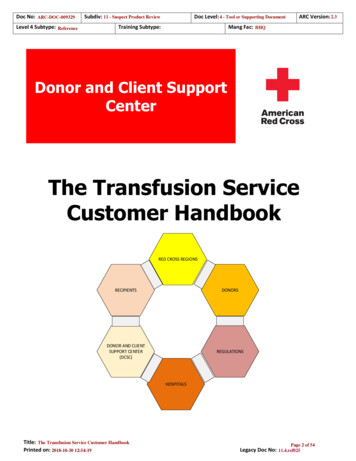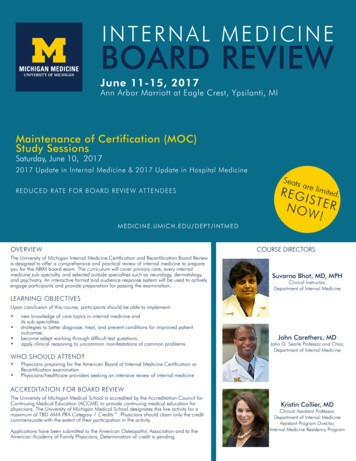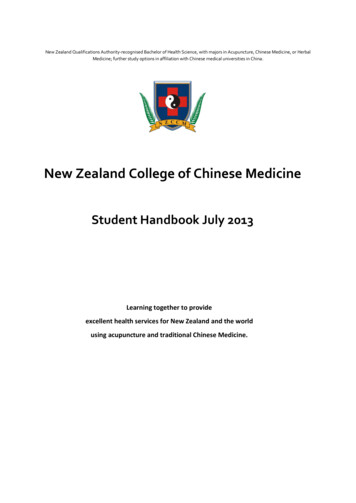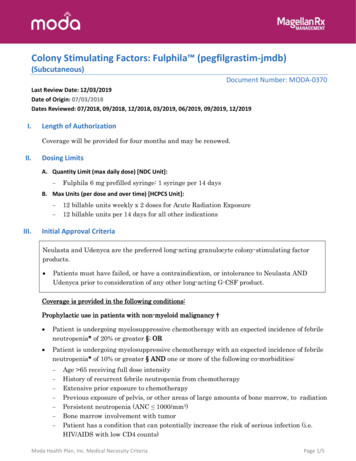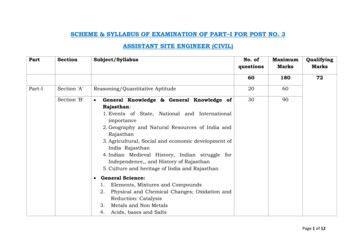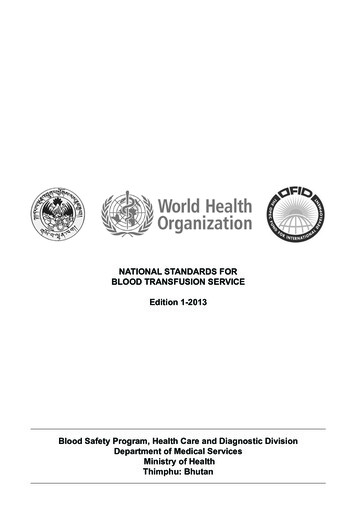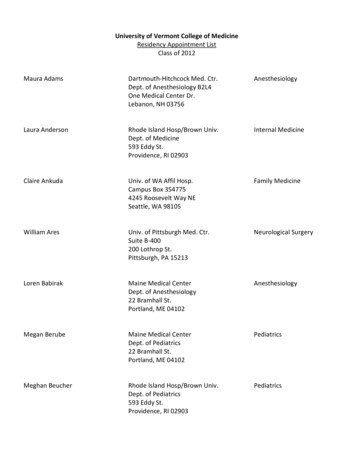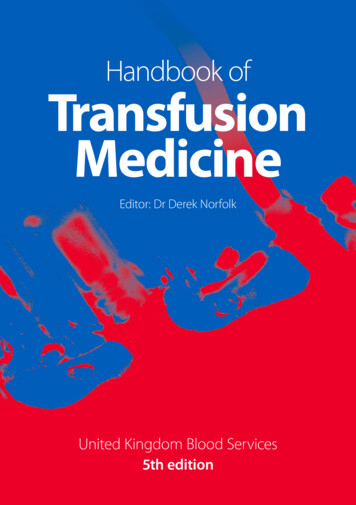
Transcription
Handbook ofTransfusionMedicineEditor: Dr Derek NorfolkUnited Kingdom Blood Services5th edition
Handbook ofTransfusionMedicineEditor: Dr Derek NorfolkUnited Kingdom Blood Services5th edition
Published by TSO and available from:Onlinewww.tsoshop.co.ukMail, Telephone, Fax & E-mailTSOPO Box 29, Norwich NR3 1GNTelephone orders/General enquiries: 0870 600 5522Fax orders: 0870 600 5533E-mail: customer.services@tso.co.ukTextphone: 0870 240 3701TSO@Blackwell and other Accredited AgentsEditorDr Derek Norfolkc/o Caroline SmithJPAC ManagerNHS Blood and TransplantLongley LaneSHEFFIELDS5 7JNEmail: caroline.smith@nhsbt.nhs.uk Crown Copyright 2013All rights reserved.You may re-use this information (excluding logos) free of charge in any format or medium, under theterms of the Open Government Licence. To view this licence, visit ment-licence/ or e-mail: psi@nationalarchives.gsi.gov.ukWhere we have identified any third party copyright information you will need to obtain permission fromthe copyright holders concerned.Applications for reproduction should be made in writing to The National Archives, Kew, Richmond,Surrey TW9 4DU.e-mail: psi@nationalarchives.gsi.gov.ukFirst published 2013ISBN 9780117068469Printed in the United Kingdom by The Stationery Office.
ContentsList of figuresixList of tablesxiPrefacexiii1 Transfusion ten commandments12 Basics of blood groups and antibodies52.1 Blood group antigens72.2 Blood group antibodies72.3 Testing for red cell antigens and antibodies in the laboratory72.4 The ABO system882.4.1Transfusion reactions due to ABO incompatibility2.5 The Rh system2.6 Other clinically important blood group systems2.7 Compatibility procedures in the hospitaltransfusion laboratory2.7.12.7.22.7.32.7.4Group and screenCompatibility testingElectronic issueBlood for planned procedures91010101011113 Providing safe blood133.1 Blood donation151616163.1.13.1.23.1.3Donor eligibilityFrequency of donationGenetic haemochromatosis3.2 Tests on blood donations3.2.1 Screening for infectious agents3.2.2 Precautions to reduce the transfusion transmission ofprion-associated diseases3.2.3 Blood groups and blood group antibodies3.2.4 Molecular blood group testing1616171717iii
Handbook of Transfusion Medicine3.3 Blood products3.3.1 Blood components3.3.2 Labelling of blood components4 Safe transfusion – right blood, right patient,right time and right place274.1 Patient identification314.2 Documentation324.3 Communication334.4 Patient consent334.5 Authorising (or ‘prescribing’) the transfusion334.6 Requests for transfusion344.7 Pre-transfusion blood sampling344.8 Collection of blood components and delivery toclinical areas354.9 Receiving blood in the clinical area354.10 Administration to the patient364.11 Monitoring the transfusion episode364.12 Technical aspects of .12.54.12.6Intravenous accessInfusion devicesRapid infusion devicesBlood warmersCompatible intravenous fluidsCo-administration of intravenous drugs and blood4.13 Transfusion of blood components5 Adverse effects of transfusion39415.1 Haemovigilance435.2 Non-infectious hazards of cute transfusion reactionsSevere and life-threatening reactionsLess severe acute transfusion reactionsDelayed transfusion reactions
Contents5.3 Infectious hazards of transfusion5.3.1 Viral infections5.3.2 Bacterial infections5.3.3 Protozoal infections5.4 Variant Creutzfeldt–Jakob disease (vCJD)6 Alternatives and adjuncts to blood transfusion6.1 Autologous blood transfusion (collection and reinfusionof the patient’s own red blood cells)6.1.16.1.26.1.36.1.4Predeposit autologous donation (PAD)Intraoperative cell salvage (ICS)Postoperative cell salvage (PCS)Acute normovolaemic haemodilution (ANH)6.2 Pharmacological measures to reduce nolytic and procoagulant drugsAprotininTissue sealantsRecombinant activated Factor VII (rFVIIa, NovoSeven )Desmopressin (DDAVP)Erythropoiesis stimulating agents (ESAs)5555585959616363646566666667676768686.3 Thrombopoietin mimetics696.4 Parenteral iron697 Effective transfusion in surgery and critical care7.1Transfusion in surgery7.1.1 Red cell transfusion7.1.2 Bleeding problems in surgical patients7.1.3 Newer oral anticoagulants7.1.4 Heparins7.1.5 Antiplatelet drugs7.1.6 Systemic fibrinolytic agents7.1.7 Cardiopulmonary bypass7.1.8 Liver transplantation7.2 Transfusion in critically ill patients7.2.17.2.27.2.3Red cell transfusion in critical carePlatelet transfusion in critical carePlasma component transfusion in critical care7.3 Transfusion management of major haemorrhage7.3.17.3.27.3.37.3.47.3.5Red cell transfusion in major haemorrhageCoagulation and major haemorrhagePlatelets and major haemorrhagePharmacological treatments in major haemorrhageAcute upper gastrointestinal bleeding7174747678787879797980808082828385868686v
Handbook of Transfusion Medicine7.3.67.3.7Major obstetric haemorrhageAudit of the management of major haemorrhage8 Effective transfusion in medical patients8.1 Haematinic deficiencies8.1.18.1.2Iron deficiency anaemiaVitamin B12 or folate deficiency8787899292928.2 Anaemia of chronic disease (ACD)928.3 Anaemia in cancer patients938.4 Anaemia and renal disease938.5 Transfusion and organ transplantation9393948.5.1 Renal transplantation8.5.2 Haemolysis after ABO-incompatible solid organ transplantation8.6 �-thalassaemia majorRed cell alloimmunisation in thalassaemiaSickle cell diseaseRed cell transfusion in sickle cell diseaseRed cell alloimmunisation in sickle cell diseaseHyperhaemolytic transfusion reactions8.7 Transfusion in 78.7.8Transfusion support for myelosuppressive treatmentRed cell transfusionProphylactic platelet transfusionRefractoriness to platelet transfusionSelection of compatible blood for patients who have received amarrow or peripheral blood HSC transplant from an ABO orRhD-incompatible donorPrevention of transfusion-associated graft-versus-host disease(TA-GvHD)Prevention of cytomegalovirus transmission by transfusionLong-term transfusion support for patients with myelodysplasia8.8 Indications for intravenous immunoglobulin (IVIg)9495959596979798989898991001021031031039 Effective transfusion in obstetric practice1059.1 Normal haematological values in pregnancy1079.2 Anaemia and pregnancy1081081099.2.1 Iron deficiency9.2.2 Folate deficiencyvi9.3 Red cell transfusion in pregnancy1099.4 Major obstetric haemorrhage109
Contents9.5 Prevention of haemolytic disease of the fetus andnewborn (HDFN)9.5.19.5.29.5.39.5.4HDFN due to anti-DPotentially sensitising eventsRoutine antenatal anti-D prophylaxis (RAADP)Anti-D Ig prophylaxis after the birth of a RhD positive baby orintrauterine death9.5.5 Inadvertent transfusion of RhD positive blood10 Effective transfusion in paediatric practice10.1 Fetal transfusion10.1.1 Intrauterine transfusion of red cells for HDFN10.1.2 Intrauterine transfusion of platelets and management of NAIT10.2 Neonatal transfusion10.2.1 Neonatal red cell exchange transfusion10.2.2 Large volume neonatal red cell transfusion10.2.3 Neonatal ‘top-up’ transfusion10.2.4 Neonatal platelet transfusions10.2.5 Neonatal FFP and cryoprecipitate transfusion10.2.6 Neonatal granulocyte transfusion10.2.7 T-antigen activation10.3 Transfusion of infants and children10.3.1 Paediatric intensive care10.3.2 Haemato-oncology patients10.4 Major haemorrhage in infants and children11 Therapeutic apheresis11.1 Therapeutic plasma exchange (TPE)11.1.1 Indications for therapeutic plasma exchange11.1.2 Risks associated with therapeutic plasma exchange11.1.3 Thrombotic thrombocytopenic purpura 12312412412512512512612712912913013111.2 Therapeutic erythrocytapheresis13111.3 Therapeutic leucapheresis13211.4 Therapeutic plateletpheresis13211.5 Therapeutic extracorporeal photopheresis13211.6 Column immunoadsorption132vii
Handbook of Transfusion Medicine12 Management of patients who do notaccept transfusion12.1 Anxiety about the risks of blood transfusion13512.2 Jehovah’s Witnesses and blood transfusion13512.3 Mental competence and refusal of transfusion136Appendices139Appendix 1: Key websites and references141Appendix 2: Acknowledgements147Abbreviations and 161
List of figuresFigure 3.1 Production of blood components and blood derivatives19Figure 4.1 Identity check between patient and blood component37Figure 5.1 Clinical flowchart for the management of acutetransfusion reactions46Figure 7.1 Guidelines for red cell transfusion in critical care81Figure 7.2 Algorithm for the management of major haemorrhage84ix
List of tablesTable 2.1Distribution of ABO blood groups and antibodiesTable 2.2 Choice of group of red cells, platelets, fresh frozen plasma(FFP) and cryoprecipitate according to recipient’s ABO groupTable 3.1Red cells in additive solution8920Table 3.2 Platelets from pooled buffy coats21Table 3.3 Platelets from apheresis donation21Table 3.4 Fresh frozen plasma22Table 3.5 Solvent detergent plasma (Octaplas )23Table 3.6 Cryoprecipitate24Table 3.7 Buffy coat (granulocytes)24Table 3.8 Granulocytes pooled buffy coat derived in additive solutionand plasma25Table 3.9 Apheresis granulocytes25Table 4.130Safe blood administrationTable 4.2 Blood component administration to adults (doses andtransfusion rates are for guidance only and depend onclinical indication)40Table 5.148Investigation of moderate or severe acute transfusion reactionsTable 5.2 Comparison of TRALI and TACO51Table 5.3 Estimated risk per million blood donations of hepatitis Bvirus, hepatitis C virus and HIV entering the blood supplydue to the window period of tests in use, UK 2010–201255Table 5.4 Confirmed viral transfusion-transmitted infections, number ofinfected recipients and outcomes reported to UK BloodServices 1996–201256Table 6.1Licensed indications and summary of dosagerecommendations for the major erythropoiesis stimulatingagents used in blood conservation68Platelet transfusion thresholds in surgery andinvasive procedures76Table 7.2Perioperative management of warfarin anticoagulation77Table 7.3Perioperative management of patients on heparins78Table 7.4Suggested indications for platelet transfusion in adultcritical care82Table 7.1xi
Table 7.5Options for fibrinogen replacement85Table 8.1Normal adult haemoglobins94Table 8.2 Indications for red cell transfusion in acute complicationsof sickle cell disease96Table 8.3 Possible indications for elective red cell transfusion insevere sickle cell disease97Table 8.4 Causes of platelet refractoriness100Table 8.5 Categories of ABO-incompatible HSC transplant101Table 8.6 Recommended ABO blood group of componentstransfused in the early post-transplant period101Table 8.7 Indications for irradiated cellular blood components inhaemato-oncology patients102Table 8.8 High-priority (‘red’) indications for intravenousimmunoglobulin – an adequate evidence base andpotentially life-saving104Table 8.9 ‘Blue’ indications for intravenous immunoglobulin –a reasonable evidence base but other treatment optionsare available104Table 9.1111Screening for maternal red cell alloantibodies in pregnancyTable 9.2 Anti-D Ig for potentially sensitising events in pregnancy112Table 10.1 Red cell component for IUT119Table 10.2 Platelets for intrauterine transfusion120Table 10.3 Red cells for neonatal exchange transfusion121Table 10.4 Summary of BCSH recommendations for neonataltop‑up transfusions121Table 10.5 Approximate capillary Hb transfusion thresholds used for‘restrictive’ transfusion policies in studies evaluated by theCochrane Review122Table 10.6 Red cells for small-volume transfusion of neonates and infants123Table 10.7 Suggested transfusion thresholds for neonatal prophylacticplatelet transfusion (excluding NAIT)123Table 11.1 ASFA Category I indications for therapeutic plasmaexchange (first-line therapy based on strongresearch evidence)130Table 11.2 ASFA Category II indications for therapeutic plasmaexchange (established second-line therapy)131xii
PrefaceAlthough the Handbook of Transfusion Medicine has reached a fifth edition, its purposeremains the same – to help the many staff involved in the transfusion chain to give the rightblood to the right patient at the right time (and, hopefully, for the right reason). Transfusionis a complex process that requires everyone, from senior doctors to porters and telephonists,to understand the vital role they play in safely delivering this key component of modernmedicine. Training and appropriate technological and managerial support for staff isessential, and e-learning systems such as http://www.learnbloodtransfusion.org.uk arefreely available. However, SHOT (Serious Hazards of Transfusion) annual reports highlightthe importance of a poor knowledge of transfusion science and clinical guidelines as acause of inappropriate and unnecessary transfusions. The handbook attempts to summarisecurrent knowledge and best clinical practice. Wherever possible it draws upon evidencebased guidelines, especially those produced by the British Committee for Standards inHaematology (BCSH). Each chapter is now preceded by a short list of ‘Essentials’ –key facts extracted from the text.We have much to congratulate ourselves about. Haemovigilance data from SHOT showthat blood transfusion in the UK is very safe, with a risk of death of around 3 in 1000 000components issued. Transfusion-transmitted infections are now rare events. Lessons fromblood transfusion about the importance of patient identification have improved many otherareas of medical practice. But not all is well. Six of the nine deaths associated withtransfusion in 2012 were linked to transfusion-associated circulatory overload (TACO),emphasising the importance of careful clinical assessment and monitoring. More than halfof serious transfusion incidents are still caused by human error, especially in the identificationof patients at sampling and transfusion, and each incident is accompanied by 100 nearmiss events. Training and competency assessment of practitioners has been only partiallyeffective and innovative solutions such as the use of bedside barcode scanners ortransfusion checklists are slowly entering practice.Most UK regions have seen a significant reduction in the use of red cells over the lastdecade, especially in surgery, but requests for platelet and plasma components continueto rise. Audits show significant variation in transfusion practice between clinical teams andpoor compliance with clinical guidelines. Changing clinical behaviour is difficult, but IT-basedclinician decision support systems, linked to guidelines, have real potential to improveprescribing of blood components. As we move from eminence-based to evidence-basedmedicine, good clinical research will be an important tool in effecting change. Since thelast edition of the handbook in 2007, there has been an encouraging growth in high-qualityresearch in transfusion medicine, including large randomised controlled trials with majorimplications for the safe and effective care of patients. These include the seminal CRASH‑2trial showing the benefit of a cheap and readily available antifibrinolytic treatment(tranexamic acid) in reducing mortality in major traumatic haemorrhage and studiesconfirming the safety of restrictive red cell transfusion policies in many surgical and criticalcare patients. High-quality systematic reviews of clinical trials in transfusion therapy are anincreasingly valuable resource. Everyone involved in transfusion has a role in identifyingclinically important questions that could be answered by further research.Paul Glaziou, professor of evidence-based medicine at Bond University in Australia, talksabout the ‘hyperactive therapeutic reflex’ of clinicians and the importance of ‘treating thepatient, not the label’. Furthermore, people increasingly want to be involved in decisionsxiii
Handbook of Transfusion Medicineabout their treatment. In transfusion medicine there is a growing emphasis on carefulclinical assessment, rather than a blind reliance on laboratory tests, in making the decisionto transfuse and using clinically relevant, patient-centred endpoints to assess the benefitsof the transfusion. For example, reducing fatigue and improving health-related quality of lifein elderly transfusion-dependent patients is more important than achieving an arbitrary targetHb level. Importantly, although guidelines outline the best evidence on which to base localpolicies they must always be interpreted in the light of the individual clinical situation.Other major changes since the last edition of the handbook include: Reduced concern that a major epidemic of variant Creutzfeldt–Jakob disease (vCJD)will occur, although many precautions, such as the importation of all manufacturedplasma products and fresh frozen plasma for patients born after 1 January 1996, remainin place. No practical vCJD screening test for blood donations has been developed. All UK countries have now introduced automated pre-release bacterial screening ofplatelet components, although the incidence of bacterial transmission had alreadyfallen significantly following better donor arm cleaning and diversion of the first20–30 mL of each donation. Implementation of the Blood Safety and Quality Regulations 2005 (BSQR) has led tothe development (and inspection) of comprehensive quality systems in hospitaltransfusion services and the reporting of serious adverse events and reactions to theMedicines and Healthcare Products Regulatory Agency (MHRA). MHRA now worksvery closely with the SHOT haemovigilance scheme with the objective of improvingpatient safety.Having edited this fifth edition of the handbook, I am increasingly impressed by theachievements, and fortitude, of my predecessor Dr Brian McClelland in taking the first fourthrough to publication. Colleagues from many disciplines have kindly contributed to orreviewed sections of the handbook (see Appendix 2) but the responsibility for any of theinevitable errors and omissions is mine alone. I would like to thank the members of the JPACStanding Advisory Committee on Clinical Transfusion Medicine for their support and advice.A special word of thanks is due to Caroline Smith for her skill and good humour in organisingso many aspects of the publication process and ensuring I met (most of) the deadlines.As well as the printed edition, the handbook will also be published in PDF and webversions that can be accessed through http://www.transfusionguidelines.org.uk. Asimportant new information emerges, or corrections and amendments to the text arerequired, these will be published in the electronic versions. Transfusion medicine ischanging quickly and it is important to use the up-to-date versions of evidence-basedguidelines. Links to key guidelines and other online publications are inserted in the textand a list of key references and useful sources of information are given in Appendix 1.Derek NorfolkAugust 2013xiv
111 Transfusion tencommandments1
2
1 Transfusion ten commandmentsEssentials Is blood transfusion necessary in this patient? If so, ensure: sion should only be used when the benefits outweigh the risks and there areno appropriate alternatives.2Results of laboratory tests are not the sole deciding factor for transfusion.3Transfusion decisions should be based on clinical assessment underpinned byevidence-based clinical guidelines.4Not all anaemic patients need transfusion (there is no universal ‘transfusion trigger’).5Discuss the risks, benefits and alternatives to transfusion with the patient and gaintheir consent.6The reason for transfusion should be documented in the patient’s clinical record.7Timely provision of blood component support in major haemorrhage can improveoutcome – good communication and team work are essential.8Failure to check patient identity can be fatal. Patients must wear an ID band (orequivalent) with name, date of birth and unique ID number. Confirm identity at everystage of the transfusion process. Patient identifiers on the ID band and blood packmust be identical. Any discrepancy, DO NOT TRANSFUSE.9The patient must be monitored during the transfusion.10 Education and training underpin safe transfusion practice.31 Transfusion ten commandmentsThese principles (which are adapted from the NHS Blood and Transplant ‘Transfusion 10commandments’ bookmark with permission) underpin safe and effective transfusionpractice and form the basis for the handbook.
22 2 Basics of bloodgroups and antibodies5
6
2 Basics of blood groups and antibodiesEssentials ABO-incompatible red cell transfusion is often fatal and its prevention is the mostimportant step in clinical transfusion practice. Alloantibodies produced by exposure to blood of a different group by transfusion orpregnancy can cause transfusion reactions, haemolytic disease of the fetus andnewborn (HDFN) or problems in selecting blood for regularly transfused patients. To prevent sensitisation and the risk of HDFN, RhD negative or Kell (K) negative girlsand women of child-bearing potential should not be transfused with RhD or Kpositive red cells except in an emergency. Use of automated analysers, linked to laboratory information systems, for bloodgrouping and antibody screening reduces human error and is essential for theissuing of blood by electronic selection or remote issue. When electronic issue is not appropriate and in procedures with a high probability ofrequiring transfusion a maximum surgical blood ordering schedule (MSBOS) shouldbe agreed between the surgical team and transfusion laboratory.There are more than 300 human blood groups but only a minority cause clinicallysignificant transfusion reactions. The two most important in clinical practice are the ABOand Rh systems.2.1Blood group antigensBlood group antigens are molecules present on the surface of red blood cells. Some, suchas the ABO groups, are also present on platelets and other tissues of the body. The genesfor most blood groups have now been identified and tests based on this technology aregradually entering clinical practice.These are usually produced when an individual is exposed to blood of a different group bytransfusion or pregnancy (‘alloantibodies’). This is a particular problem in patients whorequire repeated transfusions, for conditions such as thalassaemia or sickle cell disease,and can cause difficulties in providing fully compatible blood if the patient is immunised toseveral different groups (see Chapter 8). Some antibodies react with red cells around thenormal body temperature of 37 C (warm antibodies). Others are only active at lowertemperatures (cold antibodies) and do not usually cause clinical problems although theymay be picked up on laboratory testing.2.3 Testing for red cell antigens and antibodiesin the laboratoryThe ABO blood group system was the first to be discovered because anti-A and anti-B aremainly of the IgM immunoglobulin class and cause visible agglutination of group A or B redcells in laboratory mixing tests. Antibodies to ABO antigens are naturally occurring and arefound in everyone after the first 3 months of life. Many other blood group antibodies, such72 Basics of blood groups and antibodies2.2 Blood group antibodies
Handbook of Transfusion Medicineas those against the Rh antigens, are smaller IgG molecules and do not directly causeagglutination of red cells. These ‘incomplete antibodies’ can be detected by the antiglobulintest (Coombs’ test) using antibodies to human IgG, IgM or complement components(‘antiglobulin’) raised in laboratory animals. The direct antiglobulin test (DAT) is used todetect antibodies present on circulating red cells, as in autoimmune haemolytic anaemiaor after mismatch blood transfusion. Blood group antibodies in plasma are demonstratedby the indirect antiglobulin test (IAT). Nearly all clinically significant red cell antibodies canbe detected by an IAT antibody screen carried out at 37 C (see section 2.7).2.4 The ABO systemThere are four main blood groups: A, B, AB and O. All normal individuals have antibodiesto the A or B antigens that are not present on their own red cells (Table 2.1). The frequencyof ABO groups varies in different ethnic populations and this must be taken into accountwhen recruiting representative blood donor panels. For example, people of Asian originhave a higher frequency of group B than white Europeans. Individuals of blood group Oare sometimes known as universal donors as their red cells have no A or B antigens.However, their plasma does contain anti-A and anti-B that, if present in high titre, has thepotential to haemolyse the red cells of certain non-group O recipients (see below).Table 2.1 Distribution of ABO blood groups and antibodiesBlood groupAntigens on red cellsAntibodies in plasmaUK blood donorsOnoneanti-A and anti-B47%AAanti-B42%BBanti-A8%ABA and Bnone3%2.4.1Transfusion reactions due to ABO incompatibilityABO-incompatible red cell transfusion is often fatal and its prevention is the most importantstep in clinical transfusion practice (Chapter 5). Anti-A and/or anti-B in the recipient’splasma binds to the transfused cells and activates the complement pathway, leading todestruction of the transfused red cells (intravascular haemolysis) and the release ofinflammatory cytokines that can cause shock, renal failure and disseminated intravascularcoagulation (DIC). The accidental transfusion of ABO-incompatible blood is now classifiedas a ‘never event’ by the UK Departments of Health.Transfusion of ABO-incompatible plasma containing anti-A or anti-B, usually from agroup O donor, can cause haemolysis of the recipient’s red cells, especially in neonatesand small infants. Red cells stored in saline, adenine, glucose and mannitol (SAG-M)additive solution (see Chapter 3) contain less than 20 mL of residual plasma so the risk ofhaemolytic reactions is very low. Group O red cell components for intrauterine transfusion,neonatal exchange transfusion or large-volume transfusion of infants are screened toexclude those with high-titre anti-A or anti-B. Group O plasma-rich blood componentssuch as fresh frozen plasma (FFP) or platelet concentrates should not be given to patientsof group A, B or AB if ABO-compatible components are readily available (Table 2.2).8
2 Basics of blood groups and antibodiesCryoprecipitate contains very little immunoglobulin and has never been reported to causesignificant haemolysis. In view of the importance of making AB plasma readily available,AB cryoprecipitate manufacture and availability is a low priority for the UK Blood Services.Table 2.2 Choice of group of red cells, platelets, fresh frozen plasma (FFP) andcryoprecipitate according to recipient’s ABO groupPatient’sABO groupRed cellsPlateletsaFresh frozenplasma (FFP) bCryoprecipitateOOOOAA or BA or BOFirst choiceSecond choiceThird choiceABAFirst choiceASecond choiceOAcOAdThird choiceAABBO or BdBFirst choiceBSecond choiceOcAdBOABdThird choiceABO or AdABFirst choiceABAdABABSecond choiceA or BOAA or BThird choiceOcdaGroup B or AB platelets are not routinely availablebGroup AB FFP is often in short supplydBdO Screening for high-titre anti-A and anti-B is not required if plasma-depleted group O red cells in SAG-M are usedd2 Basics of blood groups and antibodiescTested and negative for high-titre anti-A and anti-B2.5 The Rh systemThere are five main Rh antigens on red cells for which individuals can be positive ornegative: C/c, D and E/e. RhD is the most important in clinical practice. Around 85% ofwhite Northern Europeans are RhD positive, rising to virtually 100% of people of Chineseorigin. Antibodies to RhD (anti-D) are only present in RhD negative individuals who havebeen transfused with RhD positive red cells or in RhD negative women who have beenpregnant with an RhD positive baby. IgG anti-D antibodies can cause acute or delayedhaemolytic transfusion reactions when RhD positive red cells are transfused and maycause haemolytic disease of the fetus and newborn (HDFN – see Chapter 9). It is9
Handbook of Transfusion Medicineimportant to avoid exposing RhD negative girls and women of child-bearing potential toRhD positive red cell transfusions except in extreme emergencies when no other groupis immediately available.2.6 Other clinically important bloodgroup systemsAlloantibodies to the Kidd (Jk) system are an important cause of delayed haemolytictransfusion reactions (see Chapter 5). Kell (anti-K) alloantibodies can cause HDFN and it isimportant to avoid transfusing K positive red cells to K negative girls and women of childbearing potential. Before red cell transfusion, the plasma of recipients is screened forclinically important red cell alloantibodies so that compatible blood can be selected.2.7 Compatibility procedures in the hospitaltransfusion laboratory2.7.1Group and screenThe patient’s pre-transfusion blood sample is tested to determine the ABO and RhDgroups and the plasma is screened for the presence of red cell alloantibodies capable ofcausing transfusion reactions. Antibody screening is performed using a panel of red cellsthat contains examples of the clinically important blood groups most often seen in practice.Blood units of a compatible ABO and Rh group, negative for any blood group alloantibodiesdetected, can then be selected from the blood bank, taking into account any specialrequirements on the transfusion request such as irradiated or cytomegalovirus (CMV)negative components.Almost all hospital laboratories carry out blood grouping and antibody screening usingautomated analysers with computer control of specimen identification and result allocation.
HANDBOOK OF TRANSFUSION MEDICINE 7.3.6 Major obstetric haemorrhage 87 7.3.7 Audit of the management of major haemorrhage 87 8 Effective transfusion in medical patients 89 8.1 Haematinic deficiencies 92 8.1.1 Iron deficiency anaemia 92 8.1.2 Vitamin B12 or fol
